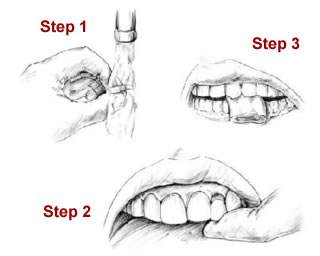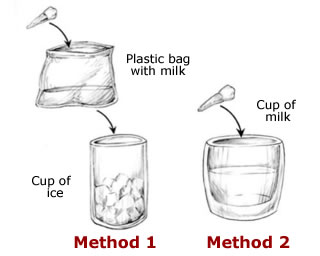Photos

FIRST AID Tooth (Adult) - Replace if Knocked Out
To save the tooth, it must be put back in the socket (re-implanted) as soon as possible. Two hours is the limit for survival of the tooth. Right away is best.
Here are the steps for putting the tooth back in the socket:
- Step 1: Rinse off the tooth with saliva or water. Do not scrub the tooth.
- Step 2: Place it in the socket facing the correct way. Press down on the tooth with your thumb until the top of the tooth is level with the adjacent tooth.
- Step 3: Lastly, bite down on a wad of cloth to stabilize the tooth until you can be seen by a dentist. If your dentist is not immediately available, then go to the emergency department (ER).
If the tooth cannot be put back in its socket: Place the tooth in either milk or saliva to keep it from drying out and go right away to the dentist. Again, If your dentist is not immediately available, then go to the ER.
Special Notes:
- Even if you get the tooth back in the socket right away, only time will tell whether the tooth will live. It may not.
- Baby teeth cannot be re-implanted.
Source: Self Care Decisions, LLC
Used with Permission from Schmitt Pediatric Guidelines LLC.

FIRST AID - Tooth (Child's) Knocked Out - Transport
To save the tooth, it must be put back in its socket as soon as possible. 2 hours is the outer limit for survival. Right away is best. If more than 30 minutes away from dental care, try to replace the tooth. Put it back in the socket before going to the dentist. Use the method below:
- Rinse off the tooth with saliva or water (do not scrub it).
- Replace the tooth into the socket, facing the correct way.
- Press down on the tooth with your thumb. Do this until the top of the tooth is level with the tooth next to it.
- Have your child bite down on a wad of cloth. This will help to keep the tooth in place until you can reach your dentist.
- Note: baby teeth can't be re-implanted.
If not able to put the permanent tooth back in its socket, follow these instructions:
- It is very important to keep the tooth moist. Do not let it dry out.
- Transport the tooth in milk or saliva. Milk is best.
- Milk Transport Option 1 (best). Place the tooth in a small plastic bag with some milk. Put the plastic bag in a cup of ice.
- Milk Transport Option 2. Place the tooth in a cup of cold milk.
- Saliva Transport Option 1 - for Child 12 Years or Older. Put the tooth inside the child's mouth. Be careful not to swallow it.
- Saliva Transport Option 2. Put the tooth in a cup. Keep the tooth moist with child's saliva (spit).
Source: Self Care Decisions, LLC
Used with Permission from Schmitt Pediatric Guidelines LLC.